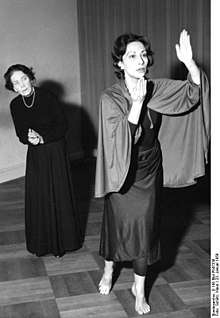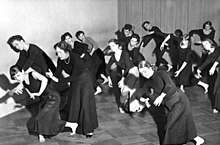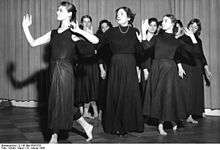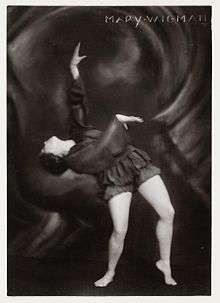Mary Wigman
Mary Wigman (born Karoline Sophie Marie Wiegmann; 13 November 1886 – 18 September 1973 in Berlin) was a German dancer and choreographer, notable as the pioneer of expressionist dance, dance therapy, and movement training without pointe shoes. She is considered one of the most important figures in the history of modern dance.[1] She became one of the most iconic figures of Weimar German culture and her work was hailed for bringing the deepest of existential experiences to the stage.
Mary Wigman | |
|---|---|
 Mary Wigman (left) | |
| Born | Karoline Sophie Marie Wiegmann 13 November 1886 |
| Died | 18 September 1973 (aged 86) |
| Nationality | German |
| Known for | modern dance and dance therapy |
| Movement | Expressionist dance |
Life

Karoline Sophie Marie Wiegmann was born in Hanover, Germany. She came to dance comparatively late after seeing three students of Émile Jaques-Dalcroze, who aimed to approach music through movement using three equally-important elements: solfège, improvisation and his own system of movements, eurhythmics.[2] Wigman enrolled in the Jaques-Dalcroze's school in Dresden in 1911. Another key early experience was a solo concert by Grete Wiesenthal.[3]
The Jaques-Dalcroze school's practice made dance secondary to music, so Wigman decided to take her interests elsewhere. In 1913, she was introduced to Rudolf Laban and Courtney Neilson in Ascona, Switzerland. She enrolled in one of Rudolf Laban's summer courses and was instructed in his technique.[4] Following their lead, she worked upon a technique based in contrasts of movement; expansion and contraction, pulling and pushing. She continued with the Laban school through the Switzerland summer sessions and the Munich winter sessions until 1919[5] During these years and through the First World War, she worked as Laban's assistant in Leipzig.[3]
After her departure from the Laban school, she retreated to the mountains of Switzerland to develop her expressionist style. She named her new dance style "New German Dance," using the word new to express the break from traditional classical ballet. She wanted her dance to be an expression of human's desires, passions, and inspirations.[6] She was deeply interested in the relationship between humans and the cosmos, and she wanted to give life to the individual forces surrounding humans. She wanted to create a technique that did not need codification, but rather, it arose out of visual interpretations of the desires of human being. In her mind, any movement could be considered dance if it is expressing a true feeling. Her technique and choreography often consisted of "sliding, bouncing, vibrating, falling/dropping, and tensions."[7]
In 1918, she suffered a nervous breakdown.[8] Two years later, in 1920, she was offered the post of ballet mistress at the Dresden State Opera, but, after taking up residence in a hotel in Dresden and beginning to teach dance classes while awaiting her appointment, she learned that the position had been awarded to someone else.[9]
In 1919, Wigman performed her first solo concert in a professional setting in Berlin, Hanover, and Bremen. These concerts were not well received by the public, but she continued to perform. Later that year, she received high praise from audiences in Hamburg, Zurich, and Dresden, and her name became known. By the mid-1920s, her name was associated in Germany with "Ausdruckstanz," which translates to Expressionist Dance.[10]
In 1920-21,[11] Wigman started her own dance school, which became known as "Dresden Central School" or simply "Mary Wigman-Schule", a centre of new, expressionist dance. This school became the center of German modern dance. The rivalry and competition between her new school and the old schools of dance in Dresden emerged, especially with the Palucca School of Dance.[11]

Her students and collaborators from Europe included Yvonne Georgi, Hanya Holm, Harald Kreutzberg, Gret Palucca, Margarethe Wallmann, Inge Weiss, and Meta Vidmar who, in 1930, established the first school of modern dance in Slovenia. She formed a dance troupe as well, which toured the world beginning in 1923.
Mary Wigman toured the United States in 1930 with her company of dancers, as well as 1931 and 1933. A school was founded by her disciples in New York City in 1931. Her choreography inspired communist dance troupes in the 1930s in New York City[12] Her work in the United States is credited to her protegee Hanya Holm, and then to Hanya's students Alwin Nikolais and Joanne Woodbury. Another student and protegee of Wigman's, Margret Dietz, taught in America from 1953-72. During this time, her style was characterized by critics as "tense, introspective, and somber," yet there was always an element of "radiance found even in her darkest compositions." Other Dresden schools were founded in other areas of Germany, and Hanya Holm even set up one in the United States. Her style of movement and training was even utilized in German public schools. She was officially honored for her accomplishments in the early 1930s by the German government.[13]
The "Mary Wigman-Schule" existed from 1920 until 1942. However, when World War II began, the Nazis in Germany viewed her as a leftist, and they considered her dances to be degenerate. The Nazis put an end to her school, but allowed her to teach in Leipzig during the war.[14] The "Mary Wigman-Schule" continued to operate under Nazi rule in World War II, following that she obey the rule of government and fire all the Jewish dancers from her schools in Germany.
What had been the Mary Wigman-Schule was started again after the war by Dore Hoyer. Hoyer and the school created a Dances for Käthe Kollwitz which they performed in Dresden in 1946.[15]
Wigman continued to teach in Leipzig until 1949. From 1950 until her death in 1973, she taught at her newly opened school in West Berlin, which became a place where modern dancers from all over the world could unite and share ideas. Her last public performance took place in 1953.[16]
Productions


Wigman gave her first public performance in Munich in February 1914, performing two of her own dances, including one called Lento and the first version of Hexentanz (Witch Dance),[17] which later became one of her most important works.[18]
While recovering from her nervous breakdown, in 1918, Wigman wrote the choreography for her first group composition, Die sieben Tänze des Lebens (The Seven Dances of Life), which premiered several year later, in 1921.[19] After that her career and influence began in earnest.
In 1925 the Italian financier Riccardo Gualino invited Wigman to Turin to perform in his private theater and in his newly opened Teatro di Torino.[20] She had several years' success on the concert stage.
Wigman's dances were often accompanied by world music and non-Western instrumentation, such as fifes and primarily percussion, bells, including the gongs and drums from India, Thailand, Africa, and China, contrasted with silence. In later years, she used composers' talents to create music to accompany her choreography, and many choreographers began to use this tactic.[21]
She would often employ masks in her pieces, influenced again by non-western/tribal dance. She did not use typical costumes associated with ballet. The subject matters included in her pieces were heavy, such as the death and desperation that was surrounding the war. However, she did not choreograph to represent the happenings of the war; she danced to outwardly convey the feelings that people were experiencing in this hard time.[22]
Selected works

- Summer Dance
- Dream Image
- Hexentanz (witch's dance)
- Totenmal
- Dance of Lorrow
- Visions, Cycles, and the Bay
- Festive Rhythm
- Dance of Spring
See also
- Weimar culture
- Weimar Germany
- Expressionist dance
- Isadora Duncan
- Ruth St Denis
- Women in dance
References
- Rainer Metzger (2007), Berlin in the Twenties: Art and Culture 1918-33, London, p. 160.
- Mead, V. H. (1996). "More than Mere Movement – Dalcroze Eurhythmics." Music Educators Journal, 82(4), 38–41.
- Kirstein, Lincoln (1977). "The Contemporary Classical Dance". Dance (Paperback ed.). New York: Dance Horizons. ISBN 0-87127-019-6.
- Mary Wigman Facts. (2010). http://biography.yourdictionary.com/mary-wigman
- Mary Wigman Facts. (2010). http://biography.yourdictionary.com/mary-wigman.
- Mary Wigman Facts. (2010). http://biography.yourdictionary.com/mary-wigman
- Mary Wigman. German Expressionist Dancer and Choreographer. https://www.contemporary-dance.org/mary-wigman.html
- Newhall, Mary Anne Santos (2009). Mary Wigman. London; New York: Routledge. ISBN 9780203098981. pg. 26.
- Newhall (2009), p. 28.
- Mary Wigman Facts. (2010). http://biography.yourdictionary.com/mary-wigman
- Prof. Dr. Karl Toepfer, Prof. Dr. Peter Reichel, Dr. Gabriele Postuwka, Frank-Manuel Peter, Dr. Yvonne Hardt, Dr. Thomas Kupsch, Cathleen Bürgelt, Muriel Favre, Heide Lazarus (2003) Selection of documents about The Wigman School, Dresden, from the period of 1924 to 1937 Archived 2015-04-02 at the Wayback Machine, Deutsches Tanzarchiv, Köln (German Dance Archives, Cologne), SK Stiftung Kultur (SK Culture Foundation)
- John Martain, "Workers League in Group Dances", The New York Times, 24 December 1934.
- Mary Wigman Facts. (2010). http://biography.yourdictionary.com/mary-wigman
- Mary Wigman Facts. (2010). http://biography.yourdictionary.com/mary-wigman
- Partsch-Bergsohn, Isa (1994). Modern Dance in Germany and the United States: Crosscurrents and Influences. Chur: Harwood Acad. Publ. p. 122. ISBN 3718655578.
- Mary Wigman Facts. (2010). http://biography.yourdictionary.com/mary-wigman
- Newhall (2009), p. 22.
- Levin, Gaby (8 March 2016)"The German Choreographer Who Danced Too Close to the Nazis", haaretz.com; retrieved 22 February 2017.
- Newhall (2009), pp. 115–116.
- Grau, Andree; Jordan, Stephanie (1 June 2002). Europe Dancing: Perspectives on Theatre, Dance, and Cultural Identity. Routledge. p. 107. ISBN 978-1-134-69653-6. Retrieved 26 July 2015.CS1 maint: ref=harv (link)
- Mary Wigman Facts. (2010). http://biography.yourdictionary.com/mary-wigman
- Mary Wigman. German Expressionist Dancer and Choreographer. https://www.contemporary-dance.org/mary-wigman.html
Further reading
- Gilbert, Laure (2000). Danser avec le Troisième Reich, Brussels: Editions Complex, ISBN 2-87027-697-4
- Karina, Lilian & Kant, Marion (2003). German Modern Dance and the Third Reich, New York & Oxford: Berghahn Books, ISBN 1-57181-688-7
- Kolb, Alexandra (2009). Performing Femininity. Dance and Literature in German Modernism. Oxford: Peter Lang. ISBN 978-3-03911-351-4
- Manning, Susan (1993). Ecstasy and the Demon: Feminism and Nationalism in the Dances of Mary Wigman, University of California Press. ISBN 0-520-08193-5.
- Martin, John (1934). "Workers League In Group Dances", The New York Times, 24 December.
- Newhall, Mary; Santos, Anne (2009). Mary Wigman. Routledge. ISBN 0-415-37527-4
- Partsch-Bergsohn, Isa; Bergsohn, Harold (2002). The Makers of Modern Dance in Germany: Rudolf Laban, Mary Wigman, Kurt Jooss, Princeton Book Company Publishers. ISBN 0-87127-250-4.
- Song, Ji-yun (2006). "Moving bodies and political movement: Dance in German modernism", dissertation, Stanford University.
- Song, Ji-yun (2007). "Mary Wigman and German Modern Dance: A Modernist Witch?", Forum for Modern Language Studies, Oxford University Press (1 October 2007), 43(4): 427–437. Special Issue on Stagecraft and Witchcraft.
- Toepfer, Karl Eric (1997). Empire of Ecstasy: Nudity and Movement in Germany Body Culture, 1910-1935 (Weimer and Now: German Cultural Criticism, No 13), University of California Press. ISBN 0-520-20663-0.
- Wigman, Mary (1975). The Mary Wigman Book: Her Writings, Olympic Marketing Corp. ISBN 0-8195-4079-X.
External links
| Wikimedia Commons has media related to Mary Wigman. |